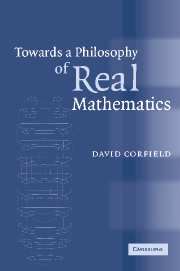Book contents
- Frontmatter
- Contents
- Preface
- 1 Introduction: a role for history
- PART I HUMAN AND ARTIFICIAL MATHEMATICIANS
- 2 Communicating with automated theorem provers
- 3 Automated conjecture formation
- 4 The role of analogy in mathematics
- PART II PLAUSIBILITY, UNCERTAINTY AND PROBABILITY
- PART III THE GROWTH OF MATHEMATICS
- PART IV THE INTERPRETATION OF MATHEMATICS
- Appendix
- Bibliography
- Index
3 - Automated conjecture formation
Published online by Cambridge University Press: 22 September 2009
- Frontmatter
- Contents
- Preface
- 1 Introduction: a role for history
- PART I HUMAN AND ARTIFICIAL MATHEMATICIANS
- 2 Communicating with automated theorem provers
- 3 Automated conjecture formation
- 4 The role of analogy in mathematics
- PART II PLAUSIBILITY, UNCERTAINTY AND PROBABILITY
- PART III THE GROWTH OF MATHEMATICS
- PART IV THE INTERPRETATION OF MATHEMATICS
- Appendix
- Bibliography
- Index
Summary
Induction, i.e. inference based on many observations, is a myth. It is neither a psychological fact, nor a fact of ordinary life, nor one of scientific procedure.
(Popper 1963: 53)The same point has sometimes been formulated by saying that it is not possible to construct an inductive machine. The latter is presumably meant as a mechanical contrivance which, when fed an observation report, would furnish a suitable hypothesis, just as a computing machine when supplied with two factors furnishes their product. I am completely in agreement that an inductive machine of this kind is not possible.
(Carnap 1950: 193)INTRODUCTION
Conjecture formation stands alongside theorem proving as a fundamental kind of mathematical activity. Any prospective completely automated mathematical reasoner must not only be able to demonstrate results deductively, but must also devise worthwhile ones to feed into its prover module. The artificial intelligence community is naturally well aware of this need. Indeed, when Larry Wos (1988) raised what he considered to be thirty-three pivotal questions for workers in the field, the thirty-first of them asked:
What properties can be identified to permit an automated reasoning program to find new and interesting theorems, as opposed to proving conjectured theorems?
(Wos 1988: 63)One form the input data to such a program might take is a list of existing theorems and conjectures.
- Type
- Chapter
- Information
- Towards a Philosophy of Real Mathematics , pp. 57 - 79Publisher: Cambridge University PressPrint publication year: 2003



